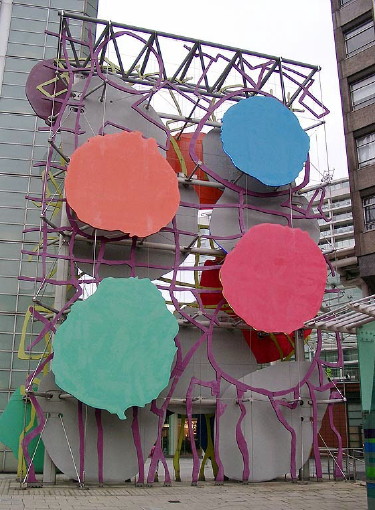Artist:
Patrick Heron
Title:
Big Painting Sculpture
Year:
1996
Adress:
Stag Place
www.createvictoria.com:
If you walk out of Cardinal Place towards Buckingham Palace, you will encounter one of the boldest pieces of public art in London. It looks like giant tiddlywinks have challenged each other to a race up a climbing wall – in fact, the work is ‘Big Painting Sculpture’ by the St Ives School artist Patrick Heron. The 19m-tall structure is supported by aluminium masts and is constructed from metal squiggles and 18 irregularly shaped, brightly coloured discs: yellow, violet, red and shades of blue from ultramarine to cobalt.
Born in Leeds in 1920, Heron settled in Cornwall in the Fifties, where he was influenced by other artists based there, including Barbara Hepworth. His abstract approach was also influenced by the fauvism of Braque and Matisse – particularly the colourful collage works of the latter. ‘All colour is madly exciting as far as I'm concerned,’ he said.
Today, Heron’s paintings can be seen in museums including New York’s MOMA, the Scottish National Gallery and the National Portrait Gallery. But the sculpture in Victoria is the most accessible of all.
It was commissioned by Land Securities back in 1998, and became one of the first examples of the company’s commitment to public art, as well as offering a creative and elegant solution to a practical problem of wind blowing through the passageway (given that Heron’s house was on a hilltop in Cornwall, he knew all about windbreaks!). The construction of the sculpture was a family affair, as it was his son-in-law, the architect Julian Feary, who was charged with realizing Heron’s concept in three dimensions and grand scale.
‘Big Painting Sculpture’ was unveiled in July 1998 and, although the artist sadly died a year later, his legacy lives on – not only in his own piece of public art, but in the policy that Land Securities has maintained ever since of including an element of public art in all its developments.
www.en.wikipedia.org:
Patrick Heron made several Public Works, in 1992 he designed the coloured glass window for Tate St.Ives and in 1996 a site specific outdoor installation at Stag Place 'Big Painting Sculpture' in collaboration with his son in law Julian Feary of Feary and Heron Architects.
If you walk out of Cardinal Place towards Buckingham Palace, you will encounter one of the boldest pieces of public art in London. It looks like giant tiddlywinks have challenged each other to a race up a climbing wall – in fact, the work is ‘Big Painting Sculpture’ by the St Ives School artist Patrick Heron. The 19m-tall structure is supported by aluminium masts and is constructed from metal squiggles and 18 irregularly shaped, brightly coloured discs: yellow, violet, red and shades of blue from ultramarine to cobalt.
Born in Leeds in 1920, Heron settled in Cornwall in the Fifties, where he was influenced by other artists based there, including Barbara Hepworth. His abstract approach was also influenced by the fauvism of Braque and Matisse – particularly the colourful collage works of the latter. ‘All colour is madly exciting as far as I'm concerned,’ he said.
Today, Heron’s paintings can be seen in museums including New York’s MOMA, the Scottish National Gallery and the National Portrait Gallery. But the sculpture in Victoria is the most accessible of all.
It was commissioned by Land Securities back in 1998, and became one of the first examples of the company’s commitment to public art, as well as offering a creative and elegant solution to a practical problem of wind blowing through the passageway (given that Heron’s house was on a hilltop in Cornwall, he knew all about windbreaks!). The construction of the sculpture was a family affair, as it was his son-in-law, the architect Julian Feary, who was charged with realizing Heron’s concept in three dimensions and grand scale.
‘Big Painting Sculpture’ was unveiled in July 1998 and, although the artist sadly died a year later, his legacy lives on – not only in his own piece of public art, but in the policy that Land Securities has maintained ever since of including an element of public art in all its developments.
www.en.wikipedia.org:
Patrick Heron made several Public Works, in 1992 he designed the coloured glass window for Tate St.Ives and in 1996 a site specific outdoor installation at Stag Place 'Big Painting Sculpture' in collaboration with his son in law Julian Feary of Feary and Heron Architects.



